And you thought it would be a short, uneventful week…
It was a boring pre-Thanksgiving week in equities picking through the Q3 GDP revision and a handful of Retail stock earning reports until the OPEC news hit on Thursday, right as we were all getting ready for turkey. With OPEC’s decision to not cut production, energy buying consumers and companies were given a massive gift as the price of oil and energy-related commodities fell 10%. So when the markets opened Friday, portfolios were busily adjusting to a new world with $60 Oil. And so Retail, Transportation, and Consumer Good stocks soared while any stock remotely tied to making money off of the Oil patch gave investors quick indigestion. While the price moves were sharp on Friday, given the half day in the U.S. equity markets, it is likely there are still portfolio moves to be made as liquidity increases and portfolio managers have more time to talk to their analysts this week.
Here is the graph of winners and losers for the week…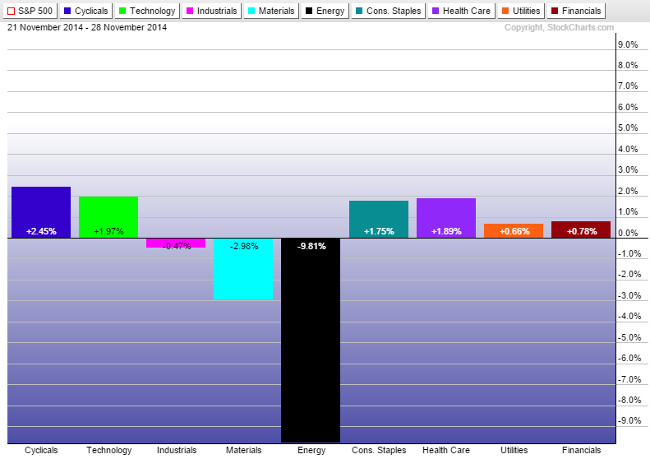
After OPEC’s announcement, it is tough to argue that this is not the best chart of 2014…
Crude oil prices have fallen more than 30% from their highs earlier this year, and while people have attributed this tumble to many things, one thing cannot be ignored: U.S. crude oil production has been exploding. In an email Thursday, Deutsche Bank (NYSE:DB) economist Torsten Slok sent around the following chart, showing the explosion in U.S. crude oil production over the past few years. Slok wrote: “The most important reason why oil prices are falling is because of the dramatic increase in recent years in U.S. crude oil production… and U.S. oil production is expected to increase further by 1 mmb/d in 2015 and 0.6-0.7 mmb/d per year in the years to 2020. In other words, expect a continued increase in oil supply going forward.”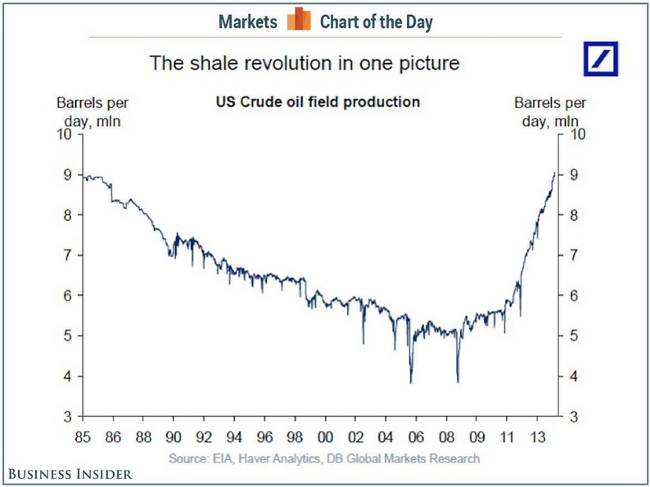
Marty Feldstein wrote about energy commodity winners and losers last week…
The low price of oil is good news for the United States economy, because it implies higher real incomes for American consumers. Within the U.S., the lower price is transferring real income from oil producers to households, which raises short-term demand because households spend a higher proportion of their incomes than oil firms do. For the same reason, the lower price also gives a boost to aggregate demand in Europe, Asia, and other oil-importing regions.
The big losers from falling oil prices include several countries that are not friends of the U.S. and its allies, such as Venezuela, Iran, and Russia. These countries are heavily dependent on their oil revenue to support their governments’ spending – especially massive transfer programs. Even at $75 or $80 a barrel, these governments will have a difficult time financing the populist programs that they need to maintain public support.
Although Saudi Arabia and several of the Gulf States are also major oil exporters, they differ from other producers in two important ways. First, their cost of extracting oil is extremely low, which means they will be able to produce profitably at the current price – or even at a much lower price. Second, their enormous financial reserves allow them to finance their domestic and international activities for an extended period of time, as they seek to transform their economies to reduce their dependence on oil revenue
Cornerstone Macro puts some numbers on paper after the Thursday OPEC news…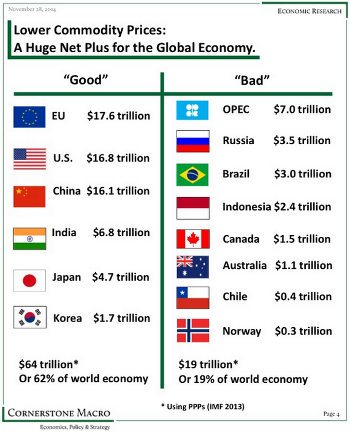
Sub $2 gasoline soon to hit gas stations in low tax states…
“We could see the cheapest 1 percent of stations get within a few pennies of $1.99 over the next two weeks,” Patrick DeHaan, a senior petroleum analyst at GasBuddy Organization Inc., said yesterday by phone from Chicago. “We’ll see at least one station in the nation at $2 by Christmas. And that’s not really a prediction at all. That’s more like a certainty.” The motor fuel has slid by almost a dollar a gallon in the U.S. from this year’s peak, giving Americans at least $500 annually in extra disposable income by IHS Inc. (NYSE:IHS) estimates. The last time the country’s average gas price was below $2 was on March 24, 2009, while in the grips of the recession
Former BP (LONDON:BP) Exec, Nick Butler, suggests that energy prices could continue to decline…
Technology in many different ways is adding to supply and reducing demand. In the past decade, technology has opened up the potential of shale gas in the U.S., the international ripples of which are still being felt. Coal has been pushed out of the U.S. power sector, with the result of world prices are falling. Gas to gas competition will soon be the norm. Technology has also raised recovery rates and cut costs, taking the industry into deeper water and opening up new provinces. Technology is reducing costs in some parts of the renewables business – especially solar. Cars use less fuel per mile and through meters and smart grid technology we can fine tune the amounts of energy we consume.
Those advances are still spreading through the system. The key moment will be when shale gas production starts in China and the advances in solar reach the commercial market. But technology does not stop, and investments made over the past decade especially, but not exclusively, in the U.S. and China will produce more advances.
The basic point is this is a structural shift, which will continue. Some technical changes (for example, the development of information and communications technology) encourage additional consumption but the overall impact of innumerable technical advances is to limit demand while expanding supply. Add to this, the renewed concern around the world about energy security, which leads inevitably to higher, subsidized domestic production of at least one source of energy supply, and you have the recipe for a long-term decline in energy prices.
If energy is going lower, maybe Sue Ann Hamm should waive the divorce settlement appeal and just get that money in the bank ASAP…
Harold Hamm, chief executive of Continental Resources Inc. (NYSE:CLR), stunned a bearish crude market by scrapping all of the North Dakota energy producer’s oil hedges, betting that prices will recover soon after sinking 25 percent in recent months… The sale of all its crude oil hedge positions from October through 2016 netted Continental a $433 million one-time gain for the current quarter. With the move, Continental is effectively declaring a premature victory over OPEC. The company did not consult with credit-rating agencies before pulling contracts, and board members are confident about the move, Hamm said. “We believe the recent pullback in oil prices will ultimately prove to be beneficial to Continental,” he said, adding he believes prices will rebound to at least $85 per barrel in the near term.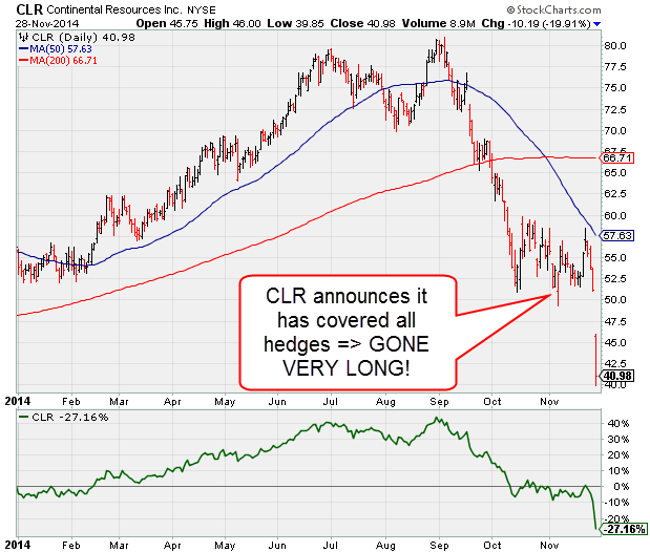
If lower Oil prices are the new normal, then will the NASDAQ 100, Euro Stocks and Bonds continue to outperform for U.S. investors?
Easy to see the November winners and losers in this chart. The equity markets are betting big on the Consumer rising…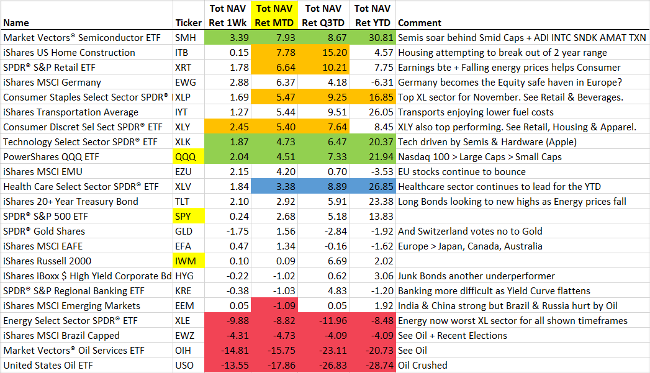
Hedge Funds likely did very well last week as Energy stocks imploded…
Looking at Goldman Sachs' (NYSE:GS) recent list of top 50 Hedge Fund long positions, only (NYSE:WMB), (TO:APC) and (ARCA:LNG) showed up as energy holdings. And if they are long this list and hedging with the S&P 500 or other indexes with any energy exposure, then Black Friday could end up being one of their best days of 2014.
The number of Large Cap All-Time Highs surged on Friday to nearly 160 names. Below is the abbreviated list of market caps > $50b, which is led by names in the Consumer, Healthcare, Financial and Industrial sectors. Energy stocks have left the party…

Looking back to Europe, the local German index launched higher. If Putin backs down with energy prices breaking Russia, Germany should gain even more strength…
Junk and Junkier-Junk bonds sink lower…
Here is your reason why Junk stinks in 2014. Too much exposure to Energy…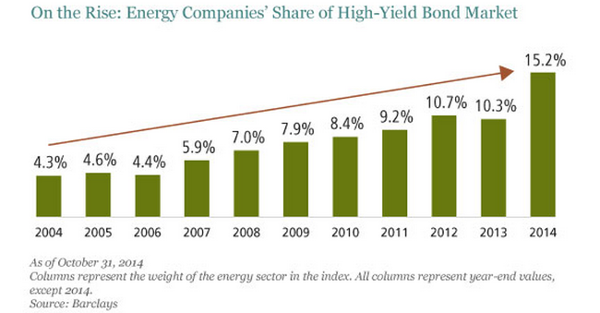
Since 2000, energy companies have invested some $1.5 trillion into operations—mostly exploration and production—and they’ve taken on a hefty share of debt to do it. Debt issued by energy firms today comprises more than 15% of the Barclays US High Yield Index, compared to less than 5% a decade ago
Even the banking industry is starting to smart from some Energy loans done at the peak. Will banks be able to absorb what they have underwritten? This will be another headwind for bank/financial stocks and their ETFs in addition to the flattening yield curve…
Now banks are also being affected, with Barclays and Wells said to face potential losses on an energy-related loan. Earlier this year, the two banks led an $850m “bridge loan” to help fund the merger of Sabine Oil & Gas and Forest Oil (NYSE:FST), U.S.-based oil companies. Investors, however, balked at buying the loan when it was first offered in June and slumping oil prices combined with volatile credit markets in the months since have scuppered further attempts to sell, or syndicate, the loan, according to market participants. Barclays and Wells declined to comment. With underwriting banks unable to offload the loan to investors, they are now facing losses on the deal as the value of the two oil companies’ debt erodes. Sabine’s bonds were trading above their face value at around $105.25 in June, but have since fallen to $94.25 – firmly in “distressed” territory. Their yield – which moves inversely to price – has jumped from around 7.05 per cent to 13.4 per cent. Rival bankers estimate that if Barclays and Wells attempted to syndicate the $850m loan now, it could go for as little as 60 cents on the dollar
Finally, we only have a 90 second trailer and already 40m fans have viewed it followed by multiple articles in The Washington Post arguing over the new Jedi lightsaber. Only four days have passed and already some incredible fan art and Lego videos of the trailer have been made. Congrats Disney (NYSE:DIS). We can’t wait
If you like the ideas Blaine Rollins shares each week in the 361 Capital Research Briefing…
Then you should learn more about how he incorporates these ideas in the new mutual fund he is managing, the 361 Global Macro Opportunity Fund. Contact 361 Capital or your advisor for additional information.
The information presented here is for informational purposes only, and this document is not to be construed as an offer to sell, or the solicitation of an offer to buy, securities. Some investments are not suitable for all investors, and there can be no assurance that any investment strategy will be successful. The hyperlinks included in this message provide direct access to other Internet resources, including Web sites. While we believe this information to be from reliable sources, 361 Capital is not responsible for the accuracy or content of information contained in these sites. Although we make every effort to ensure these links are accurate, up to date and relevant, we cannot take responsibility for pages maintained by external providers. The views expressed by these external providers on their own Web pages or on external sites they link to are not necessarily those of 361 Capital.
